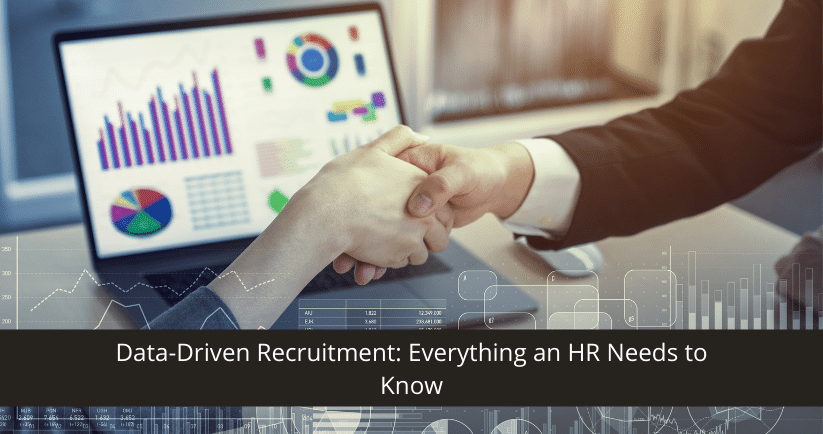The data-driven trend is catching up a lot of pace amidst businesses these days and the fad doesn’t seem to dither anytime soon. Whilst businesses in the past used to rely on other human resource tactics, today it has all boiled down to numbers and by numbers, we mean ‘data’. In order to attract the best talents in today’s cutthroat recruitment market, harnessing the power of next-gen technologies, tools and strategies has become an integral aspect of a recruiter’s life.
The entire process of hiring is a treasure chest which when mined judiciously unearths a pool of information and data on whether a particular candidate can make the best fit for your organisation or not. So it’s time to bid adieu to gut feelings and save yourself from the horrors of hiring a wrong employee.
Before delving any further, let us first understand what data-driven recruitment actually looks like. It is a facts-based approach focused on leveraging workforce intelligence, which is a fine combination of strategic workplace planning and HR analytics. This allows recruiters and talent acquisition experts to address the most critical hiring concerns with confidence and accuracy.
So there is no solid reason as why recruiters should refrain from embracing a data-driven and analytical approach when it comes to recruiting. Here are five core benefits of a data-driven recruitment campaign.
1. Gives you more quality hires
The mere ability of tracking new recruits or potential candidates helps to determine what makes a particular candidate an excellent pick. Data-driven recruitment experts can dig deep into key metrics such as the following:
- Qualified and proficient applicants
- Past resignations history say for less than 6 months of service
- New recruit performance
2. Predicts the speed of recruitment
Just think how cool it would be if you can provide accurate recruitment estimate to your boss! If done appropriately, data-driven recruitment management software would enable HR and talent acquisition experts to foresee how long it would take a candidate to complete the hiring process. This equips you with a credible timeline that you can pitch to your boss. Similarly, a data-driven approach can uproot the bottlenecks that may hinder the hiring process, all well ahead of time. Simply put, this is how predictive analytics would up the game for HR.
3. Improves candidate experience
Whilst candidate experience has long been a hot debate since decades, many businesses still find it challenging to hone this crucial part of the recruitment process. In fact, there are several areas talent acquisition experts and recruiters ought to work on. The question is how do you locate those areas?
Analytics can bring to light the factors that affect candidate experience, whereas workforce intelligent data would suggest suitable measures to tackle these problems. Whether it is the time your HR department responds to the candidate since the first contact, time between interview/screening stages, etc., you can easily figure out what makes a candidate withdraw his application.
4. Infuses diversity in your hiring process
Conventional hiring techniques make it difficult to foretell whether you will be able to attain those diversity benchmarks or whether you can ensure impartiality in the process. Rather than relying on guesswork, use data-driven analytics to monitor your recruitment funnel on a regular basis for key demographic metrics such as employment status, ethnicity and gender. This would empower you to track diversity in a much better manner and increase diversity in your hiring process.
5. Keeps your recruitment capacity in check
Hiring is all about maintaining a fine balance, i.e. excess hiring can incur additional costs, whereas under hiring can lead to productivity issues. Thus to maintain the balance, you require facts-based and data-driven recruitment strategies that reflect the current state of organisation. Here, data-driven workforce intelligence enables talent acquisition leaders to devise accurate and feasible recruitment plans backed by historical data for factors like employee turnover, hiring process, etc. Most importantly, it offers a good picture of your spend. Thus, recruiters would come to know if they are overspending or underspending on hiring.
Closing the Curtain:
If you are still stuck with traditional methods, chances are high that you may be resorting to spreadsheets and generating tons of reports from multiple systems to improve your hiring process. This certainly is a cumbersome and tiring process. So why not consider investing in a new technology that will speed up things whilst providing you with all the crucial data.
Cloud based HRMS solution with automation and predictive analytics module would not only help you keep a bird’s eye view on your hiring pipeline, but would also help with accurate and unbiased performance appraisals by pulling out historical data on top performing employees in the company.
Last but not the least, remember that data-driven analytics is not a one-time task. Thus, businesses ought to make sure that it is an ongoing process carried out in a religious manner for continuous improvement of the hiring process.
To know how a cloud based HRMS solution can put an end to all your woes pertaining to employee management, contact us here. You can also give us a shout-out at Twitter and Facebook or SMS SAGE to 56767 or drop a mail at sales@pockethrms.com
Disclaimer: All the information, views and opinions expressed in this blog are those of the authors and their respective web sources and in no way reflect the principles, views or objectives of Pocket HRMS.








